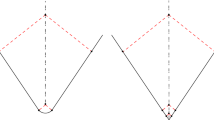Abstract
An algorithm is presented which generates a triangular mesh to approximate an iso-surface. It starts with a triangulation of a sphere and next applies a series of deformations to this triangulation to transform it into the required surface. These deformations leave the topology invariant, so the final iso-surface should be homeomorphic with a sphere. The algorithm is adaptive in the sense that the lengths of the sides of the triangles in the mesh vary with the local curvature of the underlying surface. A quantitative analysis of the accuracy of the algorithm is given along with an empirical comparison with earlier algorithms.
Similar content being viewed by others
References
van Overveld K, Bottino A, Nuij W (1996) How to shrinkwrap a sadle-point: an algorithm for the adaptive triangulation of iso-surfaces with arbitrary topology. Proceedings of the Eurographics Workshop Implicit Surfaces, Eindhoven, the Netherlands, published by Eindhoven University of Technology
Blinn J (1982) A Generalization of Algebraic Surface Drawing. ACM Trans Graph 1:235
Bloomenthal J (1988) Polygonisation of Implicit Surfaces. Comput Aided Geom Design 4(5):341–355
Bloomenthal J, Wyvill B (1990) Interactive Techniques for Implicit Modeling. Comput Graph 24(2):109–116
Bloomenthal J (1997) Introduction to Implicit Surfaces. Morgan Kaufmann, ISBN 1-55860-233-X, 1997. Edited by Jules Bloomenthal With Chandrajit Bajaj, Jim Blinn, Marie-Paule Cani-Gascuel, Alyn Rockwood, Brian Wyvill, Geoff Wyvill
Bottino A (1995) How To Shrinkwrap a Saddle Point. Master’s thesis, Eindhoven University of Technology, Eindhoven, the Netherlands
Lorensen W, Cline H (1987) Marching Cubes: A High Resolution 3D Surface Construction Algorithm. Comput Graph (Proc. SIGGRAPH ’87) 21(4):163–169
Mallet JL Discrete smooth interpolation in geometric modelling. Comput Aid Des 24(4):178–191
Ning P, Bloomenthal J (1993) An evaluation of implicit surface tilers. IEEE Comput Graph Appl 13(6):33–41
Nishimura H, Hirai A, Kawai T, Kawata T, Shirakawa I, Omura K (1985) Object Modelling by Distribution Function and a Method of Image Generation. Journal of papers given at the Electronics Communication Conference ’85, J68-D(4), in Japanese
Requicha AAG, Voelcker HB (1983) Boolean operations in solid modelling boundary evaluation and merging algorithms. Proc IEEE 3(7):30–44
Sederberg T, Parry S (1986) Free Form Deformation of Solid Geometric Models. Comput Graph (Proc. SIGGRAPH ’86) 23(3):151–160
Turk G (1992) Re-tiling polygonal surfaces. Comput Graph (Proc. SIGGRAPH ’92) 26(2):55–64
Wilhelms J, van Gelder A (1991) A coherant Projection Approach for Direct Volume Rendering. Comput Graph (Proc. SIGGRAPH ’91) 25(4):275–284
Wyvill G, McPheeters C, Wyvill B (1986) Data Structure for Soft Objects. Vis Comput 2(4):227–234
Wyvill B (1988) The Great Train Rubbery. SIGGRAPH ’88 Electronic Theatre and Video Review, Issue 26
Author information
Authors and Affiliations
Corresponding author
Rights and permissions
About this article
Cite this article
van Overveld, K., Wyvill, B. Shrinkwrap: An efficient adaptive algorithm for triangulating an iso-surface. Vis Comput 20, 362–379 (2004). https://doi.org/10.1007/s00371-002-0197-4
Published:
Issue Date:
DOI: https://doi.org/10.1007/s00371-002-0197-4




